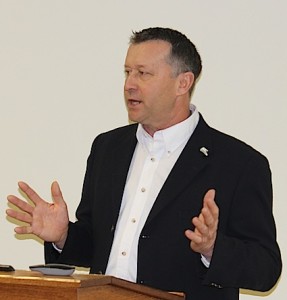HEATHER BOA Bullet News EXETER – Jim Ginn never planned to be a steward of rural property.
But after nearly 30 years of farming a 320-acre parcel nestled between Hwy. 8 and the Maitland River west of Clinton, Ginn lives by a code of responsible planning and management of land resources. He received the Countryside Canada National Award 2004 and the Ministry of Natural Resource’s Glen Hodgin Memorial Award and has involvement and founding membership in a number of local stewardship initiatives.
“To understand me, you have to understand my farm,” said Ginn, who was guest speaker at the Maitland Valley Conservation Authority’s (MVCA) annual general meeting recently.
The farm that once operated as a dairy farm and now yields purebred Red Angus beef cattle has a coldwater stream running through it, an intermittent stream that dries up in the summer months, an acreage of tall grass prairie and forest at all ends.
“I’m very fortunate to own this property. It’s beautiful. It’s not the farmstead that’s beautiful. It’s the back of the farm, along the river,” he said, passing around a book of glossy landscape photographs compiled by his two children. “The camera caught what I see: The beauty of nature and the changing scenes. All the pictures are of my farm.”
The spring following the purchase of the farm in 1985, he walked into a hardware store to replace caged and barbed wire fencing with electric fencing at his creeks, only to learn from the clerk that he could get a 75 per cent grant for the cost of fencing to keep cattle out of the stream. He liked the idea of funding but voiced aloud his concern that the land was too rough and treed for fencing by the stream and he’d have to install it at the top of the bank. That was when the clerk suggested he plant trees.
Ginn’s immediate response was that he was unprepared to give up 25 acres of his 198 workable acres just one year after purchasing the farm. But by then he was working alone, having lost his father just six months after the farm sale. And then he read an article in the Rural Voice that struck a chord with him. It was about planting trees in order to leave a legacy for your children.
So in 1988, he planted 18,000 trees along the banks of the stream.
“That’s where it all started from,” Ginn said.
Since then, he has installed fencing at both streams, built five stream crossings, retired fragile and marginal lands, moved into conservation tillage, reintroduced 36 endangered species such as sweet chestnut (bringing his tree count to 20,000), improved fish and wildlife habitat, decommissioned an old well and built a runoff containment structure, which was dependent on grants because it would not otherwise pay for itself.
Ginn said the investment in structures on the farm 25 years ago calculated in current dollars would be about $250,000, much of which was funded by grants.
Then 22 years after the original tree planting, he realized the economic benefits of land stewardship. A pine tree snapped off at the top, leaving a dry log that Ginn decided to cut down. That very tree from his woodlot resulted in about $36-worth of lumber.
“Thirty-six dollars isn’t a whole lot. But remember: Over the years, I’d planted 20,000,” he said. “It’s the dollars that add up in these projects.”
Ginn said the rate of return on trees, based on about a half-inch growth on the trunk yearly in a well-managed woodlot, is about six per cent.
“It amazes me that people are ripping out woodlots to try to farm land. Most people who are investing today would be more than happy with a six-per-cent rate of return. And yet they’re ripping out trees to try to grow a crop. At that rate of return, it doesn’t make a whole lot of sense,” he said.
He said woodlots also create diversification on the farm, and can be managed in the off-season.
During the annual general meeting, one of the MVCA’s director’s, Jason Breckenridge, announced Bill and Cindy Van Nes as winners of the 2013 Conservation Award.
The owners of St. Brigid’s Dairy Ltd., a 260-cow organic dairy farm in Morris-Turnberry have been involved in numerous stewardship programs over the years, including the Healthy Futures Program and the Huron County Clean Water Project. Their efforts have resulted in fencing to protect nearly five kilometres of watercourses, tree plantings to create 1.5-km of wind breaks, a manure storage decommissioning, clean water diversion projects with eavestroughs, and two wellhead protection projects.
During the evening, Deb Shewfelt was acclaimed for another term as the MVCA’s chair and Art Versteeg was acclaimed as vice-chair.













